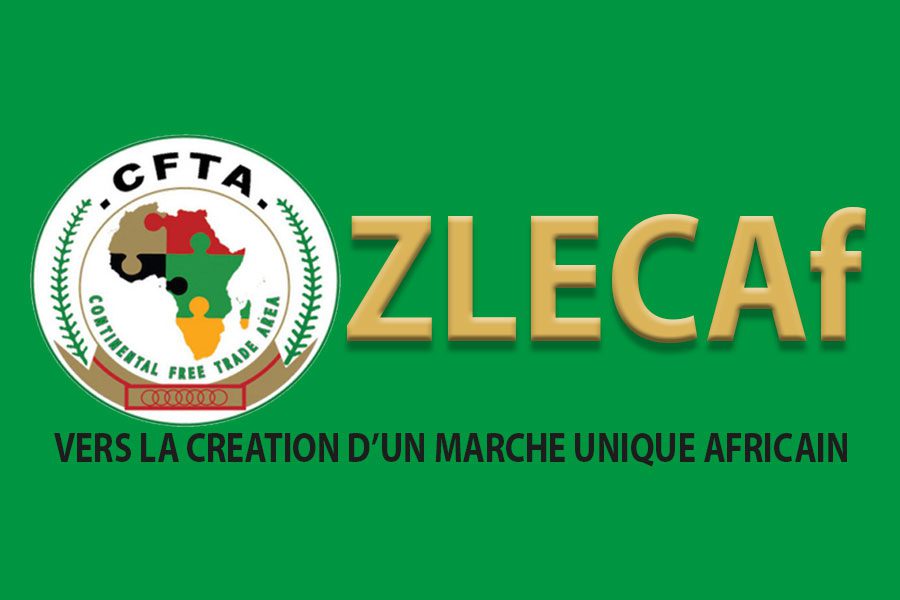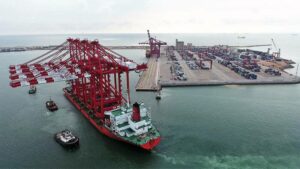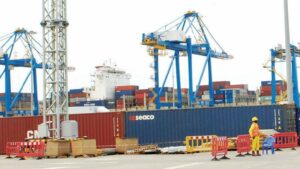
What future for the African Continental Free Trade Area (ZLECAF)?
Enhancing intra-African trade for economic integration
Economic exchanges between countries have always been a key factor in regional economic integration and wealth creation. These exchanges are aimed at promoting a single market for goods and services and creating a free trade area. This involves the movement of capital and individuals. Among other things, it facilitates investment and economies of scale, strengthens the competitiveness of national economies, contributes to inclusive and sustainable socio-economic development, regional value chain development and agricultural development for food security.
Classical economists argue for the superiority of free trade over protectionism. Wealth is measured by the number of goods and services a nation is able to trade, and free trade on an international scale is the source of national wealth. The progress of free trade has virtually eliminated traditional protectionist measures (customs duties, quotas, entry visas, etc.), instead encouraging governments to resort to neo-protectionist measures.

However, trade between African countries has always been hampered by a number of barriers. These obstacles are mainly due to mechanisms such as the imposition of exorbitant tariffs, which have prevented countries from trading their products, exchanging services, the free movement of citizens from one country to another, and the lack of communication.
The African Union, by relaunching the Africa Continental Free Trade Area (AfCFTA), sought to provide a glimmer of hope by offering significant opportunities to businesses on the continent. This structure has struggled to take off since its creation in 2021, but we are tentatively seeing the first results of this project, although it will take years for intra-African trade to produce the expected results. By joining Zlecaf, African countries will have to build their economic union with the aim of increasing the added value of their export products at continental level.
The free trade zone is taking shape for the first time. Cameroon at the forefront
The port of Kribi, Cameroon, welcomed a shipload of goods under the ‘Zlecaf’ scheme. This cargo of resin from Tunisia is the first import of goods under this free trade zone project. The project has been signed by 54 African countries, but has not yet become a reality. The cargo of resin that arrived in Cameroon at the beginning of July marks the beginning of the process of dismantling the trade zone. It marks the beginning of the dismantling of tariffs on a product allowed under the Zlecaf regime.
In all, a 20-tonne cargo of resin imported from Cameroon and destined for a paint company. This is the first product from the sub-region to benefit from a preferential customs tariff under the African Continental Free Trade Area project. The project is currently in its pilot phase, with eight countries participating, including Cameroon, Egypt, Kenya, Mauritius, Rwanda, Tanzania, Tunisia and Ghana, which hosts the headquarters of this new pan-African institution.
This import by Inoda Industries Sarl, a company specialising in the production of paints and other coating materials, is the first to be carried out under the Zlecaf regime. The processing of this cargo is of decisive importance, as it is part of the test phase for the implementation of this organisation.
This import by Inoda Industries Sarl, a company specialising in the production of paints and other coating materials, is the first to be carried out under the Zlecaf regime. The handling of this cargo is of decisive importance, as it is part of the test phase for the implementation of this organisation.
In October 2022, Cameroon embarked on this adventure to boost intra-African trade by carrying out its first exports under the Zlecaf regime. On 19 October 2022, Cameroon Customs issued two Zlecaf certificates of origin to Cameroonian agri-food companies, Cameroon Tea Estate and Ndawara Tea Estate, with a view to exporting 38.6 kg of Cameroonian tea to Ghana.
What is the objective of this new project?
Africa is about to open a new page in its economic history. Through economic integration, the continent sees Zlecaf as an essential platform to realise this ambition.
The aim is to gradually reduce customs duties to stimulate trade between African countries. Today, trade between African countries accounts for only 17% of the continent’s total trade flows. Imports from China, which will account for USD 165 billion by 2022, and Europe are preferred because they are cheaper than domestic imports to the continent.

At less than 18%, intra-regional trade is significantly lower than intra-Asian (50%) and intra-European (70%) trade. The reason for this low level of trade between African countries is the lack of information. Africa is planning to create the second largest free trade area in the world, with a potential market of 1.3 billion consumers. With an estimated GDP of almost $3 trillion, Africa intends to accelerate its internal trade and create more jobs and wealth by promoting economies of scale.
By 2035, according to a study by the African Union, the FTAA is expected to enable the African continent to commit at least USD 575 billion and reduce poverty on the continent by 60 per cent. The actual start-up is highly anticipated by all citizens of the continent, who hope to find jobs in the industries that the future trade will create.
This start-up, which looks like a trial balloon, is a first victory for the African Common Market, presented by most observers as a formidable lever to accelerate the continent’s economic growth and development.
How will small and medium-sized enterprises benefit?
Zlecaf has presented plans for a digital payment platform dedicated to African SMEs. It is expected to create a digital marketplace to facilitate trade. To ensure that SMEs benefit, Zlecaf is negotiating with banking institutions that could provide guarantees, as SMEs often face problems with credit eligibility and access to finance in the formal banking circuit.
By solving the issue of access to finance, SMEs will be able to carry out transactions, purchases and sales with the support of banking institutions, which will have to cover certain risks. Initially, four sectors are eligible for this digital payment platform. These are agriculture, textiles, pharmaceuticals and transport.
The role of Afreximbank
The creation of the free trade area requires banking structures that help countries to engage in trade by providing the necessary funds. The Afreximbank (African Export-Import Bank) was mandated to establish the Zlecaf Adjustment Fund to help countries adapt to the new liberalised and integrated trade environment. The adjustment fund will comprise a basic fund, a general fund and a credit fund.
The basic fund will consist of member countries’ contributions, grants and a technical assistance fund to cover the loss of tariff revenue that might result from the elimination of customs duties. The general fund and the credit fund will be made available to mobilise trade finance to support the public and private sectors, respectively, to enable them to adapt and take advantage of the opportunities created by Zlecaf. Afreximbank will mobilise USD 10 billion over the next 5-10 years as necessary resources in terms of adjustment funds. To date, the bank has already mobilised USD 1 billion for the Zlecaf adjustment fund.
Which products are involved in free trade?
The products involved in trade have been classified into three categories. Category A contains the imported products that will be subject to rapid liberalisation. It includes 90.01% of the tariff lines, or 5255 products. These products will be dismantled in a linear approach over a period of 10 years, until tariffs are reduced to zero. Category B comprises sensitive (locally produced) products. It comprises 6.99% of the tariff lines, i.e. a total of 408 products that the country will liberalise over 13 years, with a 5-year moratorium.
The products excluded from liberalisation constitute category C, with 175 products, representing 2.99% of the tariff lines. These are products such as wheat flour, corn flour, crude palm oil, refined palm oil, sugars, chewing gum, sweets, pasta, fruit juices, Portland cement, cement glue, hair relaxers, soaps and shower gels, aluminium profiles, etc.
Zlecaf envisages the liberalisation of 90% of the tariff lines within 10 years for Least Developed Countries (LDCs) and 5 years for developing countries; the dismantling of 7% of the so-called sensitive products within a period of 13 years for LDCs and 10 years for developing countries; and the exclusion of 3% of the remaining products from the tariff dismantling process.
What are the main challenges?
Reducing tariffs between Zlecaf countries is a good strategy to stimulate trade and make local products more competitive. However, there are still major challenges to be addressed to get this project off the ground.
The first challenge is currency convertibility. Solving the difficulties associated with convertibility of multiple currencies is crucial to facilitate payments and settlements between countries in different currency zones. There are currently 42 currencies in Africa. It would be better to ensure, for example, that a trader in Nigeria can transfer Nigerian Naira to a counterpart in Tanzania who will receive Tanzanian shillings.
Synchronise regional economic communities, which form the ‘spaghetti bowl’. This is a long-term hope, which necessarily implies the consolidation of the 14 regional economic communities that make up the continent. Some countries are members of more than one organisation at the same time.
After this phase, countries will have to move away from primary specialisations and develop their industries and the tertiary sector. Most of Sub-Saharan Africa’s exports remain primary. Almost 80 per cent comes from agriculture, forestry, mining and oil. Africa has become a strategic reserve of hydrocarbons and mineral resources. Promoting industries is a key step for countries, as it helps to increase trade.
Intensify local content. This is the policy of industrial revitalisation, to promote industrialisation with local roots. The Local Content Act aims to prioritise national goods and services. Countries will then have to work on their absolute and comparative advantages.
In their trade, therefore, countries will try to stimulate market dynamics. It is estimated that Zlecaf will increase intra-African trade by more than 50 per cent by eliminating import duties, and will double this trade if non-tariff barriers are also eliminated. In the five areas analysed, taking into account trade integration, regional infrastructure, manufacturing integration, free movement of people and macroeconomic integration, for example, only SADC is an exception in terms of flexibility, having abolished internal tariffs and moving towards a customs union.
The customs union will only be effective if the countries unanimously decide to eliminate practices that are viciously abnormal. One of these practices is the lack of free movement of people. In most cases, Africans have to pay for a visa to travel from one African country to another. Only thirteen countries offer free access to their borders. Other anomalies are the time it takes to clear goods through customs, the number of checkpoints and the lengthy administrative procedures.
This is where the product war must be avoided. The Zlecaf commission has every interest in defining the rules of origin…. ‘Made in… Rules of origin are the criteria used to determine the country of origin of a product. To this end, Member States will have to present, draw up and submit lists of 90% of their products that should be liberalised, as well as sensitive products that should be liberalised in the long term. Integration theory teaches that institutional convergence can play a driving role in the process of regional integration. This requires the creation of common rules in the form of coordination and harmonisation of national standards, procedures and policies.
Given the existing inequalities in the distribution of earnings, it is important to draw the attention of member states to the need to create areas of solidarity. African countries have different economic configurations and will be affected in different ways by Zlecaf. Solidarity requires special and differential treatment for LDCs and financial resources to compensate for the costs of integration and to compensate countries with significant gaps in expected earnings.
It is therefore up to the previously established countries and regional zones to think about streamlining their relations outside Zlecaf. As things stand, the various agreements made with external partners risk limiting the ability to implement the Zlecaf agenda. Externally, African governments will most likely continue to abide by World Trade Organisation rules as well as bilateral treaties.
Another obstacle to trade facilitation is the logistical challenge. Infrastructure limitations in Africa are a significant factor in the low level of trade. Communication is also crucial and we know that countries have different levels of access to modern means of communication. It is important to create a reassuring digital environment. Digitalisation is a catalyst for economic recovery and its role in international trade is well established. For Zlecaf, in order to make digital technology accessible, it is essential to harmonise policies and regulations by simplifying procedures, making information available and transmitting trade rules instantly. Added to this is the data protection of the parties involved.
By increasing the flow of intra-African trade and stimulating trade relations, Africa can take control of its economic future and regain its prosperity. A future that looks like a big business.
Photographs taken from Port autonome de Kribi

